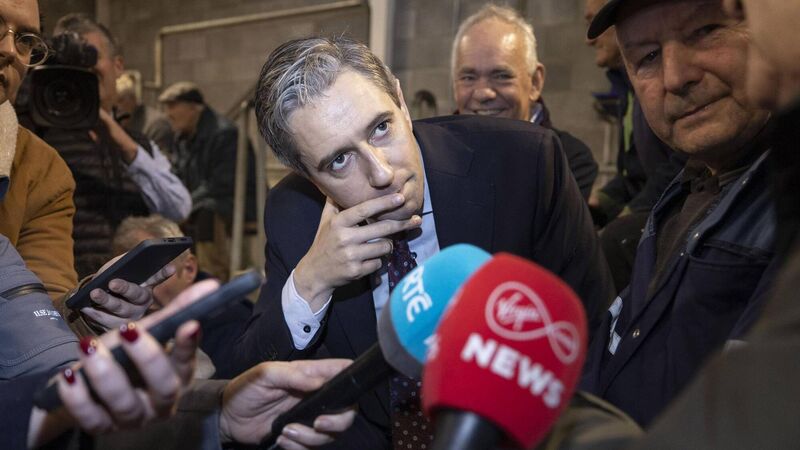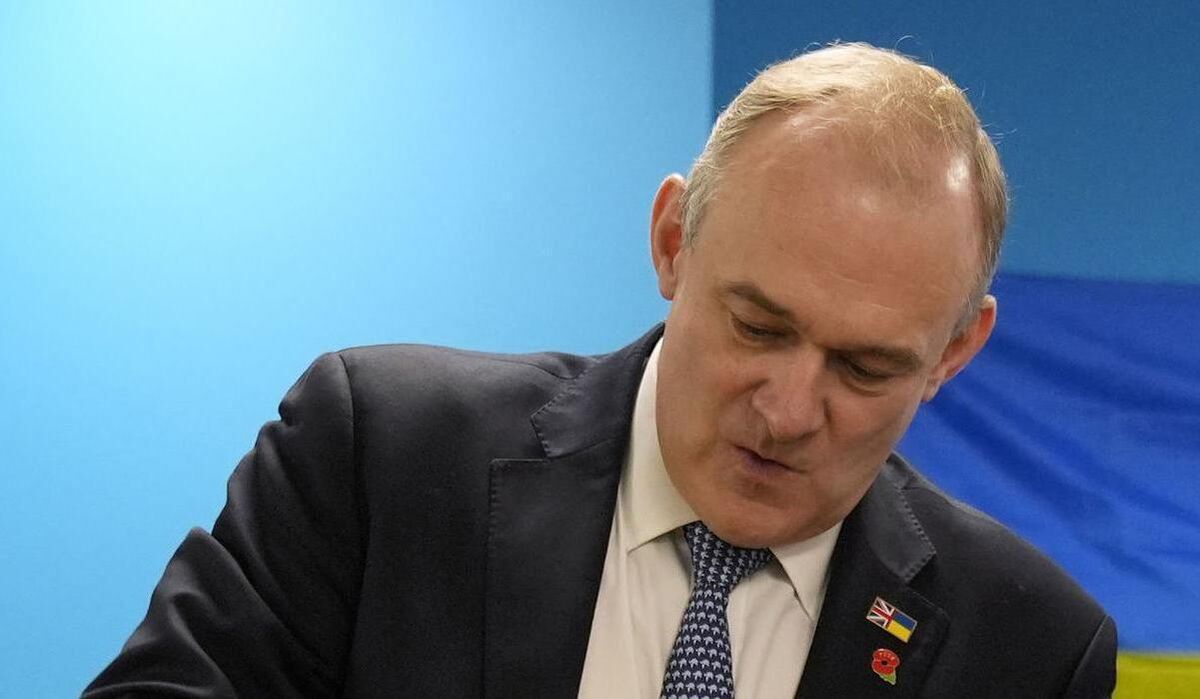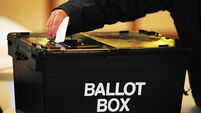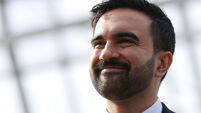Election 2024: Fight for votes will be online as much as on the doorsteps

Taoiseach Simon Harris was out canvassing for votes in Carnew Mart, Co Wicklow, on Saturday. Picture: Fergal Phillips
As the country prepares to head to the polls, will the TikTok Taoiseach retain his title or do followers actually follow through in real life?
Over the past decade, the fight for votes has taken place online just as much as on the doorsteps but even in the four years since the last general election the social media landscape has changed drastically.
With the average Irish person spending between one-and-a-half to two hours per day on social media, to underestimate its power on politics would be at your own peril.
In 2020, TikTok was still in its infancy, Elon Musk had not yet taken over Twitter, Facebook was still holding its own among millennials, and Instagram was leading the way in video content.
Today, TikTok has over two million monthly users in Ireland, thousands of people have fled Twitter, now X, in favour of newer, similar sites such as Threads, Bluesky, or Mastodon, and Facebook's demographic is increasing in age while the number of accounts declines.
Scroll for results in your area
Heading into this short and sweet election campaign, the spokespeople for the main parties are not looking to reinvent the wheel when it comes to their online campaigns.
Conversations in the lead-up to the Dáil being dissolved revealed conservative plans for this campaign.
While there is a consensus among the various campaigns that social media is just one element of campaigning, its value — and the importance of hitting the right notes — is clear as those who have unlocked a recipe for social media success try to keep the special ingredient a family secret.
In truth, there are a whole host of ways to capture the public's attention online but the real trick is consistency, consistency, consistency.
Coming into an election period, a greater emphasis will naturally be put on social media but the clever parties are using social media as a means of constantly 'canvassing' without actually having to pound the pavement.
Ministers and TDs spend a good portion of their time working in Dublin, away from their constituents, but they can engage both directly and indirectly via social media no matter where they are.
The covid lockdowns pushed many politicians to take more active roles online as it was the simplest way to reach the widest audience.
This is when Simon Harris, then the health minister, found his groove on social media filming daily videos to keep the Irish public abreast of the latest developments.
They were unpolished, off-the-cuff videos usually of Mr Harris at a desk — leaning just a little too close to the camera — and speaking directly to the viewer.
It was in these short videos that first glimmer of the TikTok Taoiseach could be seen as it placed him front and centre and, importantly, on the screens of a younger generation of soon-to-be voters.

The approach gives viewers — aka voters — the feeling that even while running the country, while travelling, while signing off on the budget in the late hours of the night, no matter what, they are his top priority.
So simple but so effective. Of course, you have some who take a very different approach. Take for example, Michael Healy Rae.
A man who has always been able to capture the public's imagination, and usually some headlines along the way, Mr Healy Rae took to social media like a duck to water.
Video is an area where he excels as is evident by the fact that he has a larger following on TikTok than Micheál Martin, Mary Lou McDonald, and Roderic O'Gorman combined.
Mr Healy Rae's page is a mix of interview clips, Dáil clips, skits, pieces to camera, and videos of him at home with family or out and about in Kerry.
It is not quite what you would call consistent but it is all Michael Healy Rae™ and that is precisely what makes it work. Social media has always been about the cult of personality.
The Kerry TD downplays his own role in the success of his social media claiming it is thanks to help from his son and a professional.
However, the simple fact that he seems to be up for anything when it comes to making content counts for a lot and this is something all the party social media teams are keenly aware of.

In fact, some of the best ideas come from politicians themselves, said one person. A good idea will only take you so far, it is the execution and timing that is key.
Richard Bruton showing off his beach bod on a boat to explain jobseeker's allowance changes or Brian Leddin's recent tongue-in-cheek love letter to Limerick Junction, ideas like these do not work without the politician's buy-in.
It has to be remembered that candidates need to avoid falling into the trap of trying to 'get down with the kids'.
This is something that most parties have flagged as they don't want candidates to be viewed as pulling stunts all the time.
Overall, candidates are learning a lot as they go, picking up tips and tricks and in 2024, many are digital natives so most parties are not keeping a tight rein on them when it comes to their individual profiles.
In their own instance, candidates will know their audience and constituents best so they can use the feedback they receive to tailor their content to maximise engagement from their voters.
Getting the candidates to feel authentic and genuine is really one of the key goals of having a social media presence so there is a resistance to micromanaging them.
Where there is a particular campaign around a specific message, there is still a collaborative discussion where people, including the politicians, will offer their insights and input but this is where things are the most structured.
Depending on the message, there are discussions around what tone and approach is best suited and then talk turns to the content itself which is as a team.
Party posts do better when they feature one or two people so usually the candidate who is the spokesperson for the particular topic will be the one involved but when they want to highlight something especially important they will generally call in the party leader.
The final piece of the puzzle is when the ideal time to post is and this is where the social media teams will turn to their analytics.
Importantly, social media can be something of a great equaliser between larger, well-financed parties and their smaller counterparts.
It can be a low-cost way for parties and candidates to draw attention and awareness that they may not receive from traditional media.
One of the easiest ways to achieve this is something that opposition parties have learned to utilise well, using short soundbites, usually clipped from Dáil footage, where they lambast the coalition parties for their perceived shortcomings in tackling the topic du jour.
Keen observers will be able to spot the moments in the Dáil chamber — from both sides of the house — that have been scripted for their short, sharp, and oh-so-shareable soundbites.
Overall, Ireland's main political parties are still searching for the social media sweet spot as the dynamic nature of the medium means the sands are constantly shifting.
But they have mostly found a rhythm despite the waves of change over the last four years.
So long as they continue to pick up some passengers along the way, they are happy to stay course.
2024 is 'the year of elections' with at least 50 nations going to the polls over these 12 months so Irish politicians don't need to look far to find examples of how to run a good online campaign.
Leaving it until the 11th hour — or month as it were — to hold an election means there are a whole host of real time blueprints mapping out the dos and don'ts for social media while attempting to woo voters.
There is simply no way to speak about election campaigns and social media in 2024 without going directly to Kamala Harris.
Apprehensions that US president Joe Biden had left it too late to step away and allow Ms Harris to become the Democratic nominee were eased within hours.
With just over three months to mount a presidential campaign against Donald Trump, who announced his bid for a second term two years ago, Ms Harris needed to hit the ground sprinting. And that it just what she did.
Ms Harris' TikTok account gained two million followers in the first 24 hours of being named the presidential nominee.
The Gen Z-led mobilisation team were around 175-strong and were ready to kick off the presidential hopeful's campaign as soon as the starter pistol was fired.

Harris' platforms immediately jumped on the biggest trends of the moment — 'brat summer' which stems from the latest album by Charli XCX and 'femininomenon' a female empowerment anthem from Chappell Roan — which proved extremely successful.
Videos of a slew of celebrities endorsing Ms Harris were shared and an old clip of her quoting her mother — "you think you just fell out of a coconut tree?" — was resurrected which capitalised on her inherent meme-ability.
These days social media trends come and go in the blink of an eye and often by the time a politician or party becomes aware of it, the internet has already moved on to the next.
Posting late is viewed as being worse than not posting at all. It gives off a vibe of being out of touch with the younger demographic along with a touch of desperation.
Whether the posts are joining in a trend or not, each post on each platform has a direct message to get across to the viewer. There are no posts just for the sake of posting.
Trending posts, as the campaign says are published "with a wink and a nod", do not undercut the seriousness of what is at stake in the election.
On the opposite side of Ireland, we have seen the Liberal Democrats take a different approach as it sought viral fame at any cost.
However, it must be acknowledged that Lib Dems garnered many headlines during the UK general election. They also returned a record number of seats.

Many will not agree with the party's approach which saw leader Ed Davey acting the clown for photo ops and viral videos viewing it as undermining his position as a figure of authority.
Along the six-week campaign trail, Mr Davey went bungee jumping from a crane, paddleboarding, taking Zumba, wheelbarrow racing, careening down a hill in Wales on a bike, and even launched his manifesto at Thorpe Park where he did an interview while riding the teacups.
A risky tactic, people were divided on whether it offered a breath of fresh air to see a politician not taking himself too seriously or showed that he did not take his position, his constituents or the issues at hand seriously.
Having come under scrutiny in the wake of the Horizon scandal that emerged earlier this year as he was postal affairs minister from 2010 to 2012, some feel his campaign antics were a distraction to deflect questions being raised about his role in the controversy.
More than 700 subpostmasters were prosecuted by the UK post office and handed criminal convictions after the Horizon IT system made it appear as though money was missing at their branches.
If that was the plan then, to a great extent, it was successful but in sidestepping serious issues, Mr Davey also distracted from the issues the Lib Dems wanted to talk about.
Mr Davey shared an emotional post about caring for his terminally ill mother and his disabled son.
At the end of the day, the Lib Dems returned more seats than anyone had predicted — including themselves — but would it be wise to follow this blueprint in the next election? Probably not.
Social media arguably offers parties the largest platform for campaigning, reaching hundreds of thousands of people from all walks of life.
When used correctly, it offers the opportunity to showcase all that a party has to offer and while there is room for levity, making that your hallmark will not build trust among the electorate that when things get real, the party can take off the clown makeup long enough to tackle the tough issues.
















